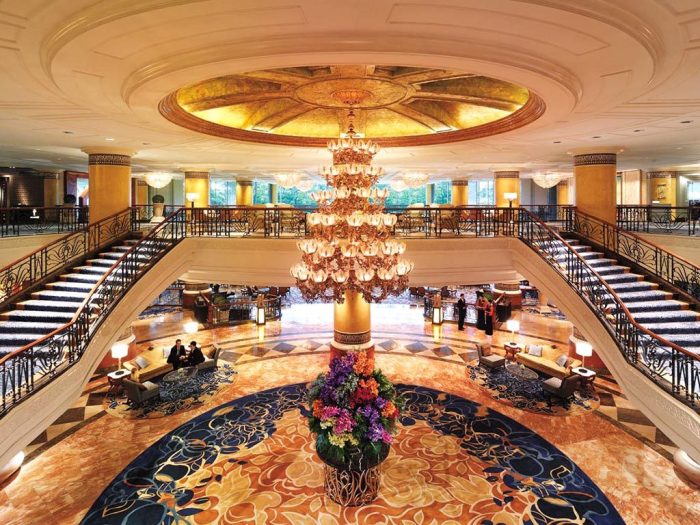5-Star Hotels Luxury Redefined
5-Star Hotels represent the pinnacle of luxury hospitality, offering an unparalleled guest experience. This exploration delves into the intricate details that define these exceptional establishments, from stringent global standards and meticulous service to innovative design and forward-thinking sustainability practices. We will examine the target market, marketing strategies, operational challenges, and financial considerations that shape the landscape of this exclusive sector.
From the meticulous criteria used for classification by organizations like Forbes and AAA to the unique cultural nuances influencing hotel features across different regions, we will provide a comprehensive overview of what makes a 5-star hotel truly exceptional. This includes analyzing successful marketing campaigns, innovative operational strategies, and the evolving role of technology in shaping the future of luxury hospitality.
Defining 5-Star Hotel Standards
Achieving 5-star status is a significant accomplishment in the hospitality industry, signifying a commitment to exceptional service, luxurious amenities, and impeccable standards. The precise criteria, however, vary depending on the rating organization used. While there’s no single, universally accepted standard, certain key elements consistently define a 5-star experience.Globally recognized rating systems such as Forbes Travel Guide (formerly Mobil Travel Guide) and AAA (American Automobile Association) employ distinct methodologies to evaluate hotels.
These organizations utilize rigorous inspection processes, assessing various aspects of the guest experience. Understanding the differences between these systems helps clarify what constitutes a truly exceptional 5-star hotel.
Global 5-Star Hotel Rating Systems
Forbes Travel Guide’s star ratings are arguably the most prestigious and stringent globally. Their inspectors conduct anonymous, on-site evaluations, meticulously scrutinizing hundreds of criteria across service, amenities, and facilities. The process involves detailed assessments of staff performance, room quality, food and beverage offerings, and overall guest experience. Achieving a Forbes 5-star rating is a testament to unwavering commitment to excellence.
In contrast, AAA’s Diamond rating system focuses on a broader range of properties, from budget-friendly motels to luxury resorts. Their evaluation considers factors such as cleanliness, comfort, and overall quality, but the depth of inspection is generally less extensive than Forbes’s. A AAA Five Diamond Award signifies exceptional quality and luxury, but the criteria are less rigorous than Forbes’s.
Key Features and Amenities of 5-Star Hotels
Several key features consistently differentiate 5-star hotels from lower-rated properties. These include, but are not limited to, spacious and exquisitely designed guest rooms with high-end amenities such as premium bedding, marble bathrooms with soaking tubs and separate showers, and high-speed internet access. Beyond the rooms, 5-star hotels often boast extensive facilities such as multiple fine-dining restaurants, world-class spas, state-of-the-art fitness centers, and personalized concierge services catering to every guest need.
Exceptional levels of service, characterized by attentive staff and proactive anticipation of guest desires, are paramount. The overall ambiance should exude luxury and sophistication.
Comparative Table: 5-Star Hotel Features Across Regions
The specific features and price ranges of 5-star hotels can vary significantly depending on geographic location. The following table illustrates this variation across three distinct regions:
| Region | Feature | Example | Price Range (USD per night) |
|---|---|---|---|
| North America (e.g., New York City) | Signature Restaurant | Michelin-starred restaurant with innovative cuisine and impeccable service. | $800 – $3000+ |
| Europe (e.g., Paris) | Historic Charm and Location | A beautifully restored hotel in a prime location with historical significance. | $700 – $2500+ |
| Asia (e.g., Singapore) | Butler Service | Personalized butler service available 24/7 to cater to every guest’s need. | $600 – $2000+ |
| North America (e.g., New York City) | Spa and Wellness Facilities | Extensive spa with a wide range of treatments, a fitness center, and yoga studios. | $800 – $3000+ |
| Europe (e.g., Paris) | Art Collection | An impressive collection of artwork displayed throughout the hotel. | $700 – $2500+ |
| Asia (e.g., Singapore) | Infinity Pool with City Views | A stunning infinity pool overlooking the city skyline. | $600 – $2000+ |
Target Market and Customer Experience: 5-Star Hotels

Source: com.ph
Understanding the target market and delivering exceptional customer experiences are paramount for 5-star hotels. These establishments cater to a discerning clientele with specific needs and expectations, demanding a level of service and luxury that goes beyond the ordinary. Successfully meeting these demands translates directly into guest satisfaction, positive reviews, and ultimately, sustained profitability.The typical 5-star hotel guest profile is multifaceted, encompassing a range of demographics and psychographics.
However, certain common threads consistently emerge.
Guest Demographics and Psychographics
High-net-worth individuals (HNWIs) constitute a significant portion of the clientele. This group often includes successful entrepreneurs, senior executives, celebrities, and affluent families. Beyond financial means, these guests value privacy, personalized service, and exclusivity. They are often well-traveled and possess a sophisticated understanding of luxury hospitality, using their experiences to set high standards. A secondary, but equally important, segment includes discerning leisure travelers seeking premium experiences for special occasions like anniversaries or honeymoons.
These individuals prioritize unique amenities, curated experiences, and exceptional service to create lasting memories. Finally, business travelers in the executive or upper management tier frequently select 5-star hotels for their convenience, comfort, and the professional image they project.
Guest Expectations and Preferences
Five-star hotel guests have high expectations across all aspects of their stay. Impeccable service is paramount; this includes prompt and anticipatory service from all staff members, from the concierge to the housekeeping team. They expect seamless check-in and check-out processes, personalized recommendations, and proactive problem-solving. The physical environment is equally crucial; guests anticipate luxuriously appointed rooms and suites with high-quality amenities, sophisticated design, and state-of-the-art technology.
Beyond the room, they value access to world-class dining options, exceptional spa and wellness facilities, and a range of curated experiences tailored to their interests. Privacy and security are also top priorities, with guests expecting discretion and a safe, secure environment. For example, the Four Seasons Hotel George V in Paris exemplifies this by offering personalized butler service and bespoke experiences catering to individual guest preferences.
Customer Journey Map for a 5-Star Hotel Stay
The customer journey for a typical 5-star hotel stay begins even before arrival. Pre-arrival communication, such as personalized welcome messages and confirmation details, sets the tone for the entire experience. Upon arrival, a seamless and efficient check-in process is essential, ideally with a dedicated concierge or guest services representative offering a warm welcome and assistance with luggage. During the stay, personalized recommendations for dining, activities, and local attractions are key.
Regular check-ins from staff to ensure guest satisfaction are vital, along with prompt and efficient responses to any requests or issues. The departure process should be equally smooth, with efficient check-out procedures and assistance with transportation arrangements. Post-stay communication, such as a thank-you note or follow-up survey, provides an opportunity to solicit feedback and strengthen guest loyalty.
The Ritz-Carlton hotel chain, known for its exceptional service, uses a detailed customer relationship management (CRM) system to track guest preferences and ensure personalized service throughout the stay.
Exceptional Customer Service Practices
Exceptional customer service in 5-star hotels often involves anticipating guest needs before they are even voiced. This might involve remembering a guest’s preferred room temperature or beverage from a previous stay, or proactively offering assistance with luggage or transportation. Proactive problem-solving is also crucial; staff should be empowered to resolve guest issues quickly and efficiently, without requiring escalation to management.
Personalized recommendations and curated experiences demonstrate a genuine understanding of the guest’s preferences and interests. For instance, the Burj Al Arab Jumeirah in Dubai offers personalized butler service, catering to every need of its guests, including arranging private helicopter tours or exclusive dining experiences. Finally, a genuine and sincere approach to hospitality is essential; staff should be trained to create a welcoming and comfortable atmosphere, making guests feel valued and appreciated throughout their stay.
Marketing and Branding Strategies
Marketing and branding are crucial for 5-star hotels to not only attract affluent travelers but also maintain their prestigious image and command premium prices. Successful strategies leverage a combination of targeted campaigns, strong brand identity, and effective communication across multiple channels. This involves understanding the unique needs and desires of the high-net-worth individual and crafting experiences that resonate with their expectations.Successful marketing campaigns for luxury hotels often focus on creating aspirational experiences rather than simply listing amenities.
They highlight the unique and personalized service, emphasizing exclusivity and bespoke experiences tailored to the individual guest’s preferences.
Successful Marketing Campaigns by Luxury Hotels, 5-Star Hotels
Several luxury hotel chains have implemented highly successful marketing campaigns. The Four Seasons Hotels and Resorts, for example, consistently emphasizes personalized service and unique local experiences in their marketing materials. Their campaigns often feature stunning visuals and compelling narratives that showcase the exceptional quality of their properties and services. Similarly, The Ritz-Carlton Hotel Company, L.L.C. focuses on its Gold Standards and commitment to impeccable service, building trust and loyalty among its discerning clientele.
Five-star hotels prioritize guest safety and comfort, employing sophisticated security measures. This often includes advanced surveillance systems, but increasingly incorporates smart home technology, such as the robust home security automation systems offered by Home Security Automation , ensuring a seamless and secure environment. Ultimately, this commitment to advanced technology elevates the overall guest experience in luxury hotels.
These campaigns are often multi-channel, utilizing print, digital, and social media platforms to reach their target audience. Ritz-Carlton’s “Ladies and Gentlemen Serving Ladies and Gentlemen” campaign highlights the personalized service offered by its employees. The emphasis is on creating an emotional connection with the brand, positioning it as more than just a place to stay, but an experience.
Branding Strategies of 5-Star Hotel Chains
Branding for 5-star hotels goes beyond a logo and tagline. It’s about cultivating a distinct brand personality and consistently delivering on the brand promise. The Peninsula Hotels, for instance, is known for its classic elegance and impeccable service, consistently reflected in its design, amenities, and staff training. The St. Regis Hotels & Resorts, a part of Marriott International, maintains a sophisticated and luxurious brand image, often associated with exclusivity and a sense of heritage.
Their branding effectively communicates their commitment to providing a refined and personalized experience. These brands carefully curate their image, focusing on consistent messaging and experiences across all touchpoints, from the website to the in-room amenities. They use a consistent brand voice, maintaining a tone that aligns with their target market’s expectations.
Effective Promotional Channels for Reaching the Target Audience
Reaching the affluent traveler requires a strategic approach to channel selection. While traditional print advertising in luxury travel magazines still holds value, digital marketing plays a crucial role. This includes targeted online advertising on platforms frequented by high-net-worth individuals, such as sophisticated travel websites and social media channels like Instagram and Facebook. Public relations and partnerships with luxury brands and travel agencies are also essential for expanding reach and building credibility.
Email marketing, when personalized and targeted, can be very effective in nurturing leads and driving bookings. Influencer marketing, particularly collaborations with luxury travel bloggers and influencers, can significantly impact brand awareness and drive bookings.
The Role of Online Reviews and Reputation Management
In today’s digital age, online reviews are incredibly influential. Positive reviews on platforms like TripAdvisor and Google Reviews are crucial for maintaining a 5-star image. Negative reviews, if not addressed promptly and professionally, can significantly damage a hotel’s reputation. Proactive reputation management involves actively monitoring online reviews, responding to both positive and negative feedback, and taking steps to address any concerns raised by guests.
This includes training staff to handle guest interactions effectively and developing systems for quickly resolving issues. A strong online reputation contributes significantly to a hotel’s ability to attract and retain affluent guests. The ability to effectively manage online reviews and maintain a positive online presence is crucial for sustaining a 5-star rating.
Operations and Management
Maintaining the seamless operation of a 5-star hotel presents a unique set of challenges, demanding meticulous attention to detail and a proactive approach to problem-solving. The high expectations of discerning guests, coupled with the complexities of managing a large and diverse workforce, require sophisticated operational strategies and a commitment to continuous improvement.
Challenges in Managing a 5-Star Hotel
The successful management of a 5-star hotel necessitates navigating several key challenges. Maintaining consistently high service standards across all departments, from housekeeping and concierge services to restaurants and spa facilities, requires rigorous oversight and a culture of excellence. Managing fluctuating occupancy rates, especially in response to seasonal changes or global events, requires careful financial planning and flexible staffing strategies.
Five-star hotels are renowned for their luxurious amenities, and a key element contributing to this experience is often the in-room entertainment. Many now boast incredibly sophisticated home theater systems, sometimes even incorporating the advanced features found in a truly Automated Home Theater , elevating the guest experience to a whole new level of comfort and entertainment. This commitment to technological excellence underscores the hotel’s dedication to providing unparalleled luxury.
Furthermore, the increasing expectation for personalized and technologically advanced services places pressure on operational efficiency and necessitates significant investment in technology and staff training. Finally, adhering to stringent safety and security protocols, alongside environmental sustainability initiatives, adds another layer of complexity to the daily operations.
Staff Training and Development
Staff training and development are paramount to maintaining the high service standards expected in a 5-star hotel. A comprehensive training program should cover not only technical skills relevant to each role (e.g., bartending, housekeeping techniques, culinary expertise) but also crucial soft skills such as communication, problem-solving, and conflict resolution. Ongoing professional development opportunities, including workshops, mentorship programs, and opportunities for advancement, foster a motivated and skilled workforce.
Regular performance reviews and feedback sessions provide opportunities for improvement and ensure consistent service delivery. Investment in staff training directly translates to improved guest satisfaction and operational efficiency, leading to enhanced profitability.
Five-star hotels are renowned for their luxurious ambiance, and a key element contributing to this is their exquisite furnishings. To achieve truly unique and bespoke spaces, many hotels collaborate with specialist firms offering services like Custom Furniture Design , ensuring every piece perfectly complements the overall aesthetic. This attention to detail elevates the guest experience, solidifying the hotel’s reputation for exceptional quality.
Technology’s Role in Enhancing Guest Experience and Streamlining Operations
Technology plays a crucial role in enhancing the guest experience and streamlining operations within a 5-star hotel. Property Management Systems (PMS) integrate various operational functions, allowing for seamless management of reservations, guest profiles, billing, and housekeeping schedules. Mobile check-in/check-out options, online concierge services, and personalized in-room entertainment systems enhance guest convenience and satisfaction. Data analytics tools provide valuable insights into guest preferences and operational efficiencies, enabling data-driven decision-making.
Furthermore, technologies such as automated room service delivery systems and smart room controls contribute to operational efficiency and enhance the guest experience. The integration of these technologies demands careful planning and implementation to ensure seamless functionality and a positive impact on both guests and staff.
Innovative Operational Strategies
Leading 5-star hotels employ several innovative operational strategies to enhance efficiency and guest satisfaction. The Four Seasons Hotels and Resorts, for example, are known for their meticulous attention to detail and personalized service, achieved through extensive staff training and a strong emphasis on employee empowerment. The Ritz-Carlton Hotel Company emphasizes anticipatory service, training staff to anticipate guest needs before they are even expressed.
Many luxury hotels are embracing sustainable practices, such as reducing water and energy consumption, using eco-friendly products, and implementing waste reduction programs, not only to meet growing guest expectations but also to demonstrate a commitment to corporate social responsibility. The implementation of these innovative strategies requires a commitment to continuous improvement and a willingness to adapt to evolving guest expectations and technological advancements.
Five-star hotels are renowned for their opulent interiors, and achieving that perfect look often begins with meticulous planning. Before a single brick is laid, designers utilize advanced visualization techniques, such as 3D Interior Design Rendering , to ensure every detail aligns with the brand’s vision. This allows for efficient adjustments and guarantees the final product flawlessly reflects the luxurious experience expected in a 5-star establishment.
Financial Aspects and Sustainability
The financial health and long-term viability of a 5-star hotel are intrinsically linked to its pricing strategies, operational efficiency, and commitment to sustainable practices. Profitability in this sector is a complex interplay of factors, demanding a nuanced understanding of both market dynamics and environmental responsibility. Balancing luxury service with responsible resource management is crucial for sustained success.
Pricing Strategies in 5-Star Hotels
Pricing for 5-star hotels is a sophisticated process that considers numerous factors. It goes beyond simply covering costs; it’s about strategically positioning the hotel within its competitive landscape and maximizing revenue potential. Key considerations include the hotel’s location, amenities, brand reputation, seasonality, and the overall demand for luxury accommodation. Dynamic pricing models, which adjust rates in real-time based on occupancy forecasts and market conditions, are frequently employed.
These models leverage sophisticated algorithms and data analytics to optimize revenue generation. For example, a 5-star hotel in a popular tourist destination might significantly increase its rates during peak season, while offering discounts during the off-season to maintain occupancy. Competitive analysis also plays a crucial role; hotels regularly benchmark their pricing against competitors with similar offerings. Ultimately, the goal is to strike a balance between maximizing revenue and maintaining a perceived value proposition that justifies the premium price point.
Factors Influencing Profitability in the Luxury Hotel Sector
Profitability in the luxury hotel sector is influenced by a multitude of interconnected factors. High operating costs, including staff salaries, premium amenities, and maintenance of opulent facilities, are significant considerations. Occupancy rates are critical; high occupancy directly translates to increased revenue. Effective revenue management strategies, as discussed previously, are crucial for maximizing occupancy and optimizing pricing. Brand reputation and guest satisfaction are also paramount; positive reviews and word-of-mouth marketing can significantly impact demand and pricing power.
Furthermore, external factors such as economic conditions, global events, and local tourism trends can influence profitability. For instance, a global recession might reduce demand for luxury travel, impacting occupancy and necessitating adjustments to pricing strategies. Conversely, a major international event hosted in the hotel’s city could drive up demand and allow for premium pricing.
Sustainable Practices in 5-Star Hotels
Many 5-star hotels are actively incorporating sustainable practices to minimize their environmental footprint and appeal to environmentally conscious guests. These initiatives often include energy-efficient technologies such as LED lighting and smart thermostats, reducing water consumption through low-flow fixtures and rainwater harvesting systems, and sourcing food locally and sustainably to minimize transportation emissions. Waste reduction programs, including composting and recycling initiatives, are also commonly implemented.
Furthermore, some hotels are investing in renewable energy sources, such as solar panels, to reduce their reliance on fossil fuels. The Four Seasons Hotel in Scottsdale, Arizona, for example, boasts extensive landscaping designed to conserve water and features a comprehensive recycling program. The Peninsula Hotels group is another example, implementing initiatives across their properties worldwide, focusing on energy efficiency and waste reduction.
Strategies for Maximizing Revenue and Occupancy Rates
Maximizing revenue and occupancy rates requires a multi-pronged approach.
- Implement a robust revenue management system to dynamically adjust pricing based on demand.
- Develop targeted marketing campaigns to reach specific customer segments.
- Offer attractive packages and promotions to incentivize bookings.
- Leverage online travel agents (OTAs) and direct booking channels effectively.
- Invest in exceptional customer service to encourage repeat business and positive reviews.
- Build strong relationships with local businesses and tourism agencies to attract referrals.
- Regularly analyze market trends and competitor strategies to adapt pricing and offerings.
- Create unique experiences and amenities to differentiate the hotel from competitors.
Design and Architecture
The design and architecture of a 5-star hotel are crucial in establishing its brand identity and delivering a luxurious experience. Architectural styles and interior design choices work in concert to create a specific ambiance, reflecting the hotel’s unique character and appealing to its target market. These elements, from the grand lobby to the smallest guest room detail, contribute to the overall perception of quality and value.
Architectural Styles
Five-star hotels often showcase a variety of architectural styles, ranging from classic to contemporary. Many embrace historical styles, incorporating elements of neoclassical, Beaux-Arts, or Art Deco architecture to create a sense of timeless elegance. Others opt for a more modern approach, featuring sleek lines, minimalist designs, and innovative materials. The chosen style significantly influences the overall aesthetic and contributes to the hotel’s unique identity.
For instance, a hotel designed in the neoclassical style might feature grand columns, ornate moldings, and symmetrical layouts, while a contemporary hotel might prioritize open spaces, natural light, and sustainable materials. The Burj Al Arab in Dubai, with its sail-shaped design, exemplifies a bold and unique architectural statement, while the Ritz Paris embodies classic Parisian elegance.
Interior Design Elements
Interior design in 5-star hotels is meticulously planned to create a luxurious and comfortable environment. High-quality materials, such as marble, polished wood, and fine fabrics, are commonly used. Attention to detail is paramount, with bespoke furnishings, handcrafted artwork, and carefully curated accessories contributing to the overall atmosphere. Color palettes are often sophisticated and calming, using neutral tones accented with pops of vibrant color.
Lighting plays a significant role in setting the mood, with layered lighting schemes creating different ambiances throughout the day. The use of natural materials, such as stone and wood, can create a sense of warmth and tranquility, while carefully selected artwork and decorative elements add personality and character.
Five-star hotels are renowned for their luxurious amenities and impeccable service. To maintain this high standard, many now incorporate advanced technology, including seamless integration with a Smart Home Hub for efficient control of lighting, temperature, and entertainment systems. This ensures a consistently refined and personalized guest experience, ultimately enhancing the overall reputation of the hotel.
Ambiance and Atmosphere
The ambiance and atmosphere of a 5-star hotel are essential to the guest experience. A luxurious hotel should evoke a sense of calm, sophistication, and exclusivity. This is achieved through a combination of factors, including the architectural style, interior design, lighting, and scent. Soft, ambient music, carefully selected artwork, and comfortable seating areas contribute to a relaxing and inviting atmosphere.
The use of natural elements, such as plants and water features, can enhance the sense of tranquility and serenity. Hotels often employ fragrance designers to create bespoke scents that complement the overall aesthetic and enhance the sensory experience. The aim is to create a holistic experience that appeals to all the senses and leaves a lasting impression on the guest.
Innovative Design Features
Modern 5-star hotels often incorporate innovative design features to enhance guest comfort and convenience. These might include smart room technology, such as automated lighting and temperature control, integrated entertainment systems, and voice-activated assistants. High-speed Wi-Fi is a standard feature, along with charging stations and ample power outlets. Some hotels incorporate sustainable design features, such as rainwater harvesting systems, solar panels, and energy-efficient appliances.
Innovative bathroom designs might include rainfall showers, heated floors, and luxurious bath products. The integration of technology and sustainable practices demonstrates a commitment to both guest satisfaction and environmental responsibility.
Design Elements Contributing to Luxury
The lobby serves as the hotel’s welcoming face, often featuring high ceilings, elegant furnishings, and impressive artwork. Guest rooms are designed for ultimate comfort and privacy, typically including spacious layouts, high-quality bedding, and luxurious bathrooms. Common areas, such as restaurants, bars, and spas, are designed to create distinct atmospheres, each tailored to its specific function. For instance, a restaurant might feature elegant table settings and sophisticated lighting, while a spa might prioritize a tranquil and serene environment.
The use of premium materials, meticulous attention to detail, and a thoughtful design approach contribute to the overall luxurious feel, reinforcing the hotel’s brand identity and exceeding guest expectations.
Competition and Future Trends
The 5-star hotel market in major cities is fiercely competitive, with established brands and new entrants vying for a share of the luxury travel segment. Understanding the competitive landscape and anticipating future trends is crucial for success in this dynamic industry. This section will analyze the competitive dynamics within a major city (using New York City as an example), explore emerging trends, and discuss the impact of technology and potential challenges and opportunities.
Competitive Analysis of 5-Star Hotels in New York City
Several luxury hotels in New York City offer distinct competitive advantages. The Peninsula New York emphasizes impeccable service and a refined, classic aesthetic, appealing to a discerning clientele seeking tradition and elegance. The Four Seasons Downtown offers a modern, sleek design with cutting-edge amenities and a focus on technology integration. The St. Regis New York, a historic landmark, leverages its legacy and exclusive experiences to attract guests seeking unparalleled luxury and heritage.
These hotels cater to slightly different segments of the luxury market, with variations in pricing, services, and overall brand identity. The Peninsula might command a slightly higher price point for its classic elegance, while the Four Seasons might attract tech-savvy travelers with its modern features. The St. Regis relies on its history and exclusivity to attract a loyal clientele.
Emerging Trends in the Luxury Hospitality Industry
The luxury hospitality industry is experiencing several notable shifts. Experiential travel is gaining prominence, with guests seeking unique and personalized experiences beyond traditional accommodations. This translates into a rise in bespoke services, curated itineraries, and collaborations with local artisans and businesses. Sustainability is also becoming a critical factor, with eco-conscious travelers increasingly seeking hotels with strong environmental commitments.
This includes initiatives such as reducing water and energy consumption, sourcing local and sustainable food, and minimizing waste. Furthermore, wellness tourism is expanding rapidly, with luxury hotels integrating wellness facilities, programs, and services to cater to the growing demand for health and well-being. Examples include dedicated yoga studios, spa treatments focusing on holistic wellness, and personalized wellness consultations.
Technological Impact on 5-Star Hotels
Technology is transforming the 5-star hotel experience. Mobile check-in/check-out, personalized in-room entertainment systems, and AI-powered chatbots are enhancing guest convenience and personalization. Smart room technology allows guests to control lighting, temperature, and entertainment with ease. Data analytics enables hotels to better understand guest preferences and tailor services accordingly, leading to enhanced customer satisfaction and loyalty. For example, a hotel might use data to anticipate a guest’s needs based on past stays, such as their preferred room temperature or type of pillow.
The implementation of sophisticated property management systems streamlines operations, improves efficiency, and reduces operational costs.
Challenges and Opportunities for 5-Star Hotels (2024-2029)
The next five to ten years present both challenges and opportunities for 5-star hotels. Maintaining profitability amidst fluctuating economic conditions and increasing operating costs will be a significant challenge. Competition from boutique hotels and alternative accommodations will require constant innovation and differentiation. Adapting to evolving guest expectations and technological advancements will be crucial for staying relevant. However, opportunities exist in expanding into new markets, developing sustainable practices, and offering unique and personalized experiences.
The rise of experiential travel and wellness tourism presents significant growth potential. Hotels that successfully integrate technology to enhance guest experience and streamline operations will gain a competitive edge. For example, the Ritz-Carlton Yacht Collection’s successful launch demonstrates the potential for expanding luxury experiences beyond traditional hotels. This diversification strategy mitigates risks associated with solely relying on traditional hotel operations.
Final Conclusion
Ultimately, the 5-star hotel experience transcends mere accommodation; it’s a curated journey designed to create lasting memories. The pursuit of excellence in every aspect, from impeccable service and luxurious amenities to sustainable practices and innovative design, defines the enduring appeal of these prestigious establishments. Understanding the complexities of their operations, marketing strategies, and financial considerations reveals a fascinating blend of artistry, precision, and a relentless commitment to exceeding guest expectations.
FAQ Guide
What is the average cost per night for a 5-star hotel?
The cost varies significantly depending on location, season, and specific hotel, ranging from several hundred to several thousand dollars per night.
Do 5-star hotels offer airport transfers?
Many 5-star hotels provide airport transfer services, often as a paid add-on or complimentary for high-value guests. It’s best to check with the hotel directly.
What types of dining options are typically available in 5-star hotels?
5-star hotels usually feature multiple dining venues, ranging from fine-dining restaurants with Michelin-starred chefs to casual cafes and bars offering diverse cuisines and ambiance.
What are the typical cancellation policies for 5-star hotels?
Cancellation policies vary widely depending on the hotel and booking terms, but often involve stricter policies and potential penalties compared to lower-rated hotels. Review the policy carefully before booking.
Are pets allowed in 5-star hotels?
Pet policies differ greatly between 5-star hotels. Some may welcome pets with additional fees, while others may have strict “no pets” policies. Always confirm with the hotel before your stay.









